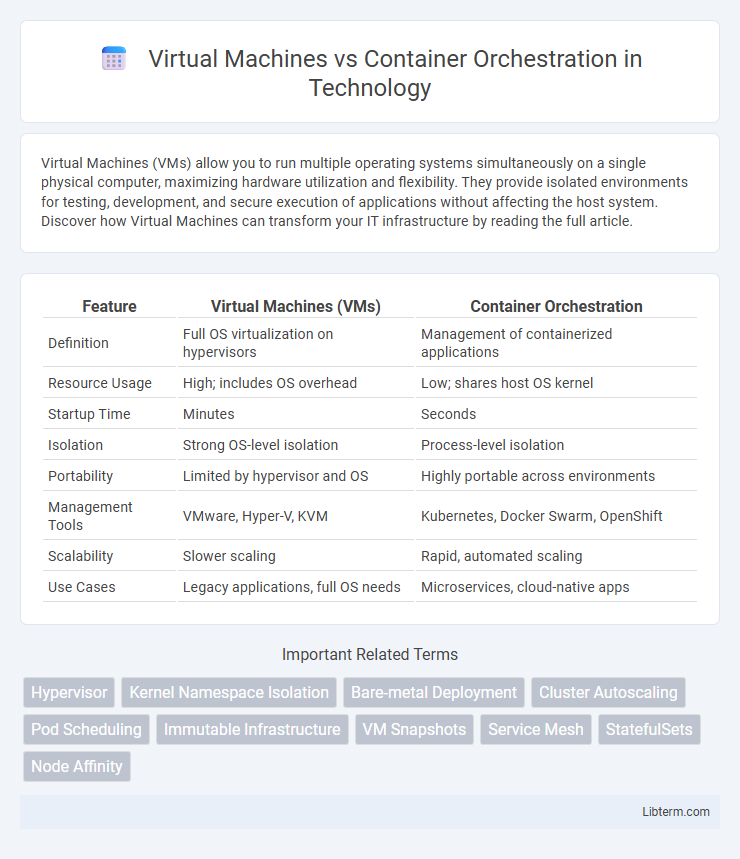Virtual Machines (VMs) allow you to run multiple operating systems simultaneously on a single physical computer, maximizing hardware utilization and flexibility. They provide isolated environments for testing, development, and secure execution of applications without affecting the host system. Discover how Virtual Machines can transform your IT infrastructure by reading the full article.
Table of Comparison
| Feature | Virtual Machines (VMs) | Container Orchestration |
|---|---|---|
| Definition | Full OS virtualization on hypervisors | Management of containerized applications |
| Resource Usage | High; includes OS overhead | Low; shares host OS kernel |
| Startup Time | Minutes | Seconds |
| Isolation | Strong OS-level isolation | Process-level isolation |
| Portability | Limited by hypervisor and OS | Highly portable across environments |
| Management Tools | VMware, Hyper-V, KVM | Kubernetes, Docker Swarm, OpenShift |
| Scalability | Slower scaling | Rapid, automated scaling |
| Use Cases | Legacy applications, full OS needs | Microservices, cloud-native apps |
Introduction to Virtual Machines and Container Orchestration
Virtual Machines (VMs) are software-based emulations of physical computers that run operating systems and applications independently, providing isolated environments with dedicated resources. Container orchestration is the automated management and coordination of containerized applications across multiple hosts, ensuring scalability, load balancing, and fault tolerance. Kubernetes and Docker Swarm are leading platforms in container orchestration, optimizing deployment through lightweight, portable containers compared to resource-intensive VMs.
Core Concepts: What are Virtual Machines?
Virtual machines (VMs) are software emulations of physical computers that run an entire operating system (OS) along with applications on virtualized hardware. They provide complete isolation with dedicated resources such as CPU, memory, and storage, enabling multiple VMs to run on a single physical host via a hypervisor. VMs ensure strong security boundaries and support diverse OS environments, making them suitable for workloads requiring full OS functionality and extensive resource allocation.
Core Concepts: What is Container Orchestration?
Container orchestration automates the deployment, management, scaling, and networking of containerized applications across clusters of machines. It handles tasks such as container scheduling, health monitoring, load balancing, and service discovery to ensure high availability and efficient resource utilization. Popular container orchestration platforms include Kubernetes, Docker Swarm, and Apache Mesos, enabling seamless management of complex microservices architectures compared to traditional virtual machine environments.
Key Differences Between VMs and Containers
Virtual Machines (VMs) run full operating systems with dedicated resources, providing strong isolation but requiring more system overhead, while containers share the host OS kernel, enabling lightweight and faster deployment. Containers offer efficient scalability through container orchestration platforms like Kubernetes, which manage application lifecycle, networking, and resource distribution across clusters. VMs excel in scenarios demanding strong security boundaries and compatibility with diverse OS environments, whereas container orchestration is optimized for microservices architectures and continuous integration/continuous deployment (CI/CD) pipelines.
Performance Comparison: VMs vs Containers
Containers deliver superior performance compared to virtual machines by utilizing shared operating system kernels, resulting in faster startup times and lower resource overhead. Virtual machines require dedicated guest OS instances, leading to increased CPU and memory consumption that can degrade overall efficiency. Container orchestration platforms like Kubernetes optimize resource utilization and scalability, enabling rapid deployment and management of microservices with minimal latency.
Scalability and Resource Management
Virtual machines provide isolated environments with dedicated resources, enabling strong security but often leading to higher overhead and slower scalability compared to containers. Container orchestration platforms like Kubernetes efficiently manage resource allocation across clusters, allowing rapid scaling of containerized applications with minimal overhead. This streamlined approach enhances resource utilization and accelerates deployment times, making container orchestration superior for dynamic, large-scale workloads.
Security Considerations
Virtual machines provide strong isolation by running separate guest operating systems on a hypervisor, reducing the risk of cross-tenant attacks. Container orchestration platforms like Kubernetes introduce shared kernel vulnerabilities, necessitating robust security policies such as namespace isolation, network segmentation, and runtime security tools. Employing vulnerability scanning, role-based access control (RBAC), and continuous monitoring are critical to secure containerized environments against escalating threats.
Use Cases: When to Choose VMs or Containers
Virtual machines suit applications requiring strong isolation, legacy software support, or complex security needs due to their fully virtualized hardware environment. Containers excel in microservices architecture, continuous deployment pipelines, and scalable cloud-native applications by offering lightweight, portable, and fast startup environments. Choose VMs for resource-intensive workloads needing dedicated OS instances, while containers are ideal for rapid development, testing, and resource-efficient environments.
Popular Tools for VMs and Container Orchestration
Popular virtual machine tools include VMware vSphere, Microsoft Hyper-V, and Oracle VM VirtualBox, known for robust infrastructure virtualization and resource management. Container orchestration is dominated by Kubernetes, Docker Swarm, and Apache Mesos, which streamline container deployment, scaling, and automation in cloud-native environments. Organizations often choose VMware or Hyper-V for traditional VM workloads, while Kubernetes is the industry standard for managing containerized applications at scale.
Future Trends in Virtualization and Containerization
Virtual Machines (VMs) and container orchestration are evolving with increased emphasis on hybrid and multi-cloud deployments, enabling more flexible and scalable infrastructure management. Future trends highlight integration of AI-driven automation to optimize resource allocation and improve workload performance for both VMs and containers. Enhanced security models and lightweight container runtime improvements are set to drive widespread adoption in edge computing and 5G environments.
Virtual Machines Infographic

 libterm.com
libterm.com